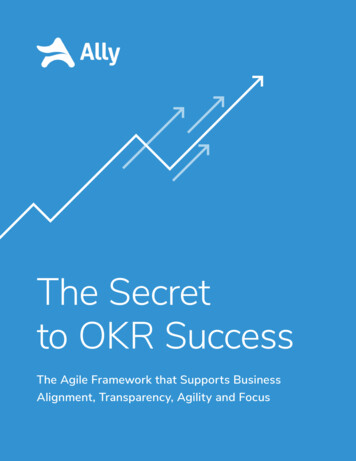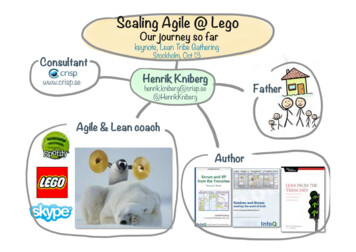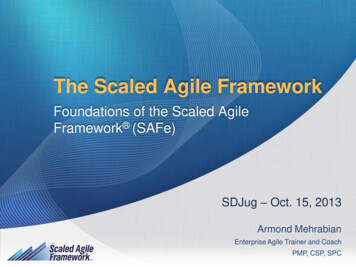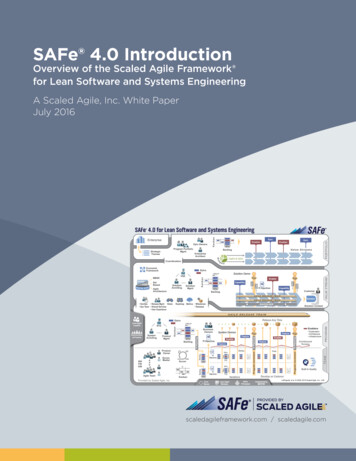
Transcription
The Secretto OKR SuccessThe Agile Framework that Supports BusinessAlignment, Transparency, Agility and Focus
IntroductionEvery industry—and every business—is affected by disruption. In the form of new customerbehaviors, new competitors and new market dynamics, disruption either present a business withnew opportunities to innovate and differentiate, or it can turn their world upside down.The problem is, most businesses are falling into the second category. Overwhelmed by newcompetitors nipping at their heels and new demands from their customer base, businessleaders are struggling to respond effectively. Business decisions must be made faster. Productdevelopment cycles must accelerate. Innovation must be embedded into the company’s DNA.It all seems so overwhelming and, frankly, impossible to tackle.In fact, research from Harvard Business Review Analytic Services, in association with theBrightline Initiative, found that only one-fifth of organizations achieve 80% or more of theirstrategic targets.These organizations are able to quickly adapt to new or unexpectedmarket changes, competitor moves, and new customer demands.The secret of their success? These implementation leaders havefound ways to overcome common organizational silos and fostermore agile ways of working.”The Secret to OKR Success2
While a multitude of new tools and apps have entered the market with the intention of tacklingthese core business challenges, there is one methodology and framework that many of theworld’s most innovative businesses use to better compete and thrive in a disruptive landscape.And that’s the OKR. Defined as “Objectives and Key Results,” the OKR was developed by AndrewGrover, President at Intel, in order to help him answer two key questions:Where do I want to go?How will I know I’m getting there?Since its successful implementation at Intel, the goal-setting framework has been adopted byGoogle, Amazon, and a growing list of brands who want to encourage aggressive goal setting,cross-functional collaboration and transparency, and improved business results.By embracing OKRs, your organization can leverage a tried and true framework these brandshave used to build and scale their businesses. This guide will serve as your foundation tosuccess, highlighting: The key components of an OKR How top organizations are using OKRs to achieve key personal and business outcomes Best practices for designing and implementing OKRs within your organizationTHE SECRET TO OKR SUCCESS3
What Are OKRs and Why IsEveryone Talking About Them?During his time at Intel, future venture capitalist and author John Doerr was introduced to theOKR by Andy Grove himself. His positive experiences with the framework encouraged him toshare it with the founders of Google in 1999. The company would go on to embed OKRs into all ofits planning processes — and many would soon follow suit. OKRs are typically part of high-levelbusiness planning. While quarterly OKRs are most common, some go through the exercise on amonthly basis. According to Doerr, who went on to author Measure What Matters, a key resourcefor anyone wanting to implement OKRs, there is a best-practice formula for goal setting:I willOBJEC TIVEas measured byKE Y RESULTS.Objectives are simply what you and your team want to accomplish. Key Results describe howyou will measure your success in accomplishing these goals—and should include time restrictionsand indicators like profit, customer count, etc. Key Results should always be measurable.This statement is reformatted into a basic structure:1. Objective: These are company, team or personal goals. They should be qualitative,actionable, ambitious and most of all, have a timeline/deadline.2. Key result: Each objective should have three to five measurable results. They should bequantifiable enough to lead to objective grading—using a 0 to 1 grading system. Whilethese results should be difficult enough to challenge you and your team, they should not beimpossible to achieve.The Secret to OKR Success4
The OKR Framework & CycleSourceAn OKR is implemented in a framework that includes a series of touch points, which areimplemented in a cycle. Management consultant Luis Gonçalves has highlighted the following ascritical to a successful OKR cycle: The company mission: A description of your company’s vision and purpose. Mid-term goals: Objectives established for the year that act as “the link” between yourcompany’s mission and the OKR. OKR planning: Strategic and tactical objectives are defined. OKR weekly: A quick weekly meeting designed to provide updates on the status of the OKR.This ensures that the OKR is integrated into day-to-day processes. OKR review: Team members assess how the OKR was handled and what they can improveupon during the next OKR cycle. OKR coach: Supports team members in the definition and implementation of OKRs.According to Gonçalves, objectives and key results do not typically change during a cycleunless an organization experiences a critical shift that needs to be addressed. However, teamsshould use the review period to determine how they can improve upon future OKRs and allcorresponding processes.The Secret to OKR Success5
OKRs vs KPIs: What’s the Difference?You may be asking what the difference is between OKRs and traditional ways to measureperformance (i.e. traditional Key Performance Indicators). According to Doerr, KPIs speak tothe performance of specific tactics and initiatives, whereas OKRs funnel up to a much largermission and vision of how your company achieves growth.OKRs speak to why specific teams and functions are trying to accomplish certain tasks andhow they will contribute to the broader business mission. When done correctly, OKRs not onlyhelp improve productivity and transparency; they motivate employees on a much deeper levelthan traditional goal setting does.Why Are OKRs Becoming A Business Must-Have?The speed at which businesses today must move is astounding. Teams must chisel away at theirlarger, strategic goals, while also juggling the seemingly endless list of last-minute tasks and dailyto-do lists. Doing so quickly and efficiently can feel rather jarring—especially because so manybusinesses are still rife with red tape and silos that inhibit seamless collaboration and information.Many businesses are implementing tools and apps designed to address these challenges,however, a survey of nearly 600 global executives conducted by Harvard Business Review AnalyticServices reveals that obstacles still remain:59%of executives say lack ofinteroperability between differentapplications and platformsis the biggest impediment tocoordinating operations.The Secret to OKR Success52%believe a single platform that combinesworkflow management with intelligentautomation and collaboration is thebest way to coordinate operations andbetter manage work and resources.6
OKRs help address these pain points by offering teams and individuals:Motivation: Many annual planning discussions are filled with lofty goals thatare no longer addressed once the meetings are over. OKRs help keep everyonemotivated by connecting team and individual objectives to larger business goalsand encouraging ongoing check-ins on progress.Alignment: OKRs present a single version of the truth for teams and in manycases, the entire business. This helps ensure that everyone is working towards thesame set of goals, which helps break down the silos that are still ever present inmany organizations.Agility: The sheer essence of an OKR is that it’s agile. They’re easy to create andconsume, and therefore, easy to refine and design as new goals are established.This is ideal for organizations as they strive to quickly respond to new disruptions.Transparency & Accountability: Specific teams can use OKRs to developfunctional and individual employee goals. For example, marketing can create abroader OKR that will then be accessible to the broader organization. This helpsimprove transparency and make other areas of the business feel like they’rein tune with new developments. Individual-level OKRs, meanwhile, help holdeveryone accountable for their goals and how they will contribute to broaderorganizational objectives. They also transform the annual review process intomore ongoing conversations with management, which can have a profound impacton employee engagement and retention.These benefits are some of the reasons why top organizations havecompletely replaced traditional business development, product innovationand even review processes, with OKRs.The Secret to OKR Success7
What OrganizationsAre Using OKRs?John Doerr’s groundbreaking book, Measure What Matters, brought OKRs into the spotlight. Init, he shared in-depth stories of how Google, The Gates Foundation and even Bono have usedthe technique to achieve explosive growth and break new ground in their industries. Althoughwe encourage you to read the book to get invaluable commentary on these and other stories, wewant to spotlight some of our favorites from the book and other resources:After receiving an onslaught of negative feedback regarding its “yank and tank system”—areview process that had managers identify their least productive employees—the companyembraced OKRs to implement more approachable “check-ins.” Rather than limitingperformance conversations to annual meetings, the “check in” system allows managers tocross-check employee objectives to their actual performance so they can better identifyand reward top performers.Despite existing for only 24 years, Amazon has made a monumental impact on the waypeople shop. From the beginning, founder Jeff Bezos established a clear mission for thecompany: “To be the earth’s most customer-centric company.” Part of accomplishing thismission means adapting its services, and adding new products, that align with customerneeds and expectations. OKRs are used extensively for goal setting and maintainingalignment as new business opportunities emerge.The Secret to OKR Success8
Since adopting OKRs in 1999, the tech giant has used them in all facets of theorganization, supporting its growth from 40 employees to more than 60,000 today acrossall brands within the Alphabet umbrella. As a business, Google relies on OKRs to helpemployees “make conscious, careful, and informed choices about how we allocate ourtime and energy—as individuals and as members of teams.”At the team level, Google uses OKRs to help people plan what they’re going to produce,track their progress and further refine future priorities and milestones. This happensat the individual level, too, so people can prioritize better and avoid time-consumingmenial tasks. Finally, Google uses cross-team OKRs to align with the ways different groupscontribute to specific goals and objectives.At LinkedIn, OKRs are largely used as a task management and tracking system, soemployees can ensure that they’re contributing to the broader mission of the business.CEO Jeff Weiner also uses OKRs to make meetings more efficient and effective. The agendais dictated by objectives met, how individual successes impact higher-level business goalsand ways employees and teams plan to tackle the objectives not yet achieved.Founder Bill Gates has spotlighted the OKR as a primary tool for anyone who wants toimprove their management style. Gates specifically uses them to get all team members onthe same page and determine how to measure success.The social network uses OKRs to improve transparency across teams. Everyone hasaccess to individual OKRs, so everyone knows who is working on what and how theyare measuring success. This ultimately helps improve communication and collaborationacross functional areas.
How Can I Successfully AdoptOKRs In My Business?The benefits of OKRs are vast and can touch multiple areas of an organization. However, theentire process—from creation, communication, tracking and adjusting—requires a cultural shift.This may feel a bit jarring, but by following these tips and best practices, your organization canbegin to embrace a more ongoing and transparent approach to cross-functional collaboration andgoal setting.Get buy-in from the top-down: Like any technology or policy, OKRs shouldbe embraced at the top and trickle down to the rest of the organization. Asindicated by earlier examples, the most successfully companies are the onesthat use OKRs at the executive level to guide big-picture strategies, and thenimplement them at the functional and personal level. This approach helpsensure that all functional (or tactical) OKRs align with the more strategicOKRs developed by the leadership team.Remember, communication is key: Improved transparency, collaborationand productivity are three of the core value propositions of OKRs.Communication is the bed rock of these benefits. Whether at the company,functional or individual level, OKRs should be embedded into dailyconversations. Meetings, team check-ins and company Town Halls are greattimes to go over progress made on key objectives and measures on how tofurther progress over the next month, quarter or beyond.The Secret to OKR Success10
Reimagine review processes: OKRs encourage more frequent goal setting,which gives leadership the opportunity to forego annual reviews and insteadconduct more frequent employee check-ins. Although OKRs certainly helpgauge progress and performance, they shouldn’t be the only indicator todictate bonuses or salary increases. In fact, making this direct correlationcould make employees see OKRs an administrative tool, rather than a toolthat encourages personal development and innovative thinking.Embrace technology to create a consistent, scalable processes: Havinga user-friendly tracking tool can help you seamlessly integrate OKRs into yourworkstream. An ideal platform integrates progress and check-ins with appsalready in use, so team members can easily embrace and refer to OKRs toguide their personal and team priorities. This will help improve employeeadoption and overall perception of the framework.The Secret to OKR Success11
It’s About the Journey,Not the DestinationLike any new process, adopting OKRs is an ongoing journey. Adoption will not happen overnight;some people will take longer than others to fully embrace them. But having a cutting-edgetool can certainly help make the process easier. From initial implementation to adoption andoptimization, a solution like Ally can help employees realize the true benefits of OKRs so youcan begin to embed them into the day-to-day processes and communication.Sign up for a 14-day free trial and learn why companies like Slack, Plaid, Remitly, andUrbanClap all choose Ally as their dedicated OKR Partner.START YOUR TRIALREQUEST DEMOAbout AllyAlly offers a simple, scalable OKR solution that enableindividuals, teams and enterprises to easily andeffectively achieve amazing results. It’s time to stopstruggling with goal-setting spreadsheets and complex,expensive, solutions, and see first-hand how your teamcan benefit from managing OKRs with Ally.10400 4th St. Suite 500, Bellevue, WA 98004contact@gotoally.com(800) 216-7507www.ally.io
OKR planning: Strategic and tactical objectives are defined. OKR weekly: A quick weekly meeting designed to provide updates on the status of the OKR. This ensures that the OKR is integrated into day-to-day processes. OKR review: Team members assess how the OKR was handled and what they can











